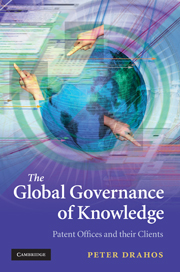Book contents
- Frontmatter
- Contents
- List of diagrams and tables
- List of abbreviations
- Preface
- 1 Patent offices and the global governance of knowledge
- 2 Labyrinths and catacombs: Patent office procedure
- 3 The rise of patent offices
- 4 The Sun and its planets: The European Patent Office and national offices
- 5 The USPTO and JPO
- 6 The age of Trilaterals and the spirit of cooperation
- 7 The jewel in the crown: India's Patent Office
- 8 The dragon and the tiger: China and South Korea
- 9 Joining the patent office conga line: Brazil
- 10 Islands and regions in the patent stream
- 11 Reclaiming the patent social contract
- 12 Patent administration sovereignty: Nodal solutions for small countries, developing countries
- Index
- References
7 - The jewel in the crown: India's Patent Office
Published online by Cambridge University Press: 03 May 2010
- Frontmatter
- Contents
- List of diagrams and tables
- List of abbreviations
- Preface
- 1 Patent offices and the global governance of knowledge
- 2 Labyrinths and catacombs: Patent office procedure
- 3 The rise of patent offices
- 4 The Sun and its planets: The European Patent Office and national offices
- 5 The USPTO and JPO
- 6 The age of Trilaterals and the spirit of cooperation
- 7 The jewel in the crown: India's Patent Office
- 8 The dragon and the tiger: China and South Korea
- 9 Joining the patent office conga line: Brazil
- 10 Islands and regions in the patent stream
- 11 Reclaiming the patent social contract
- 12 Patent administration sovereignty: Nodal solutions for small countries, developing countries
- Index
- References
Summary
Integration
At the beginning of the twenty-first century Brazil, China and India are generally talked about as high-growth economies with China and India in particular set on a path that might potentially see them each chug past the US economy in terms of size. Whatever the future holds these three countries are presently major economic powers using measures such as total GDP. All three countries have a patent law and are investing heavily in the creation of a large modern patent office. Of the three countries China is the most advanced down this path. Its patent office is an International Searching Authority (ISA) for the purposes of the Patent Cooperation Treaty (PCT). The patent offices of India and Brazil, as we saw in Chapter 6, have only just been admitted to ISA status. Both have the potential to increase the size of their offices in the way that China has because both have access to a large pool of low-cost scientific labour.
Before we examine the patent offices of these three countries in more detail we should note that the modernization of their respective offices represents the last step of the integration of these countries into the international patent regime. They are following a historical pattern that we saw inChapter 3 held true for European powers of the late nineteenth century and early twentieth century in which the modernization of patent offices occurred well after the enactment of patent law.
- Type
- Chapter
- Information
- The Global Governance of KnowledgePatent Offices and their Clients, pp. 199 - 220Publisher: Cambridge University PressPrint publication year: 2010

